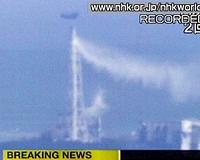| . |  |
. |
Tokyo (AFP) May 5, 2011 Workers entered a reactor building at Japan's stricken nuclear plant Thursday for the first time since an explosion hit the facility a day after the March 11 earthquake and tsunami, officials said. Wearing gas masks and protective suits with oxygen tanks on their backs, two workers stepped into the building housing reactor number one -- one of four reactors badly damaged at the Fukushima Daiichi plant -- to gauge radiation levels. "It was the first entry into the reactor building by our plant workers since the explosion," said Satoshi Watanabe, a spokesman for operator Tokyo Electric Power Company (TEPCO). "We are sending workers as a small group for a maximum of 10 minutes so that radiation they will be exposed to can be limited," Watanabe added. The company later sent in more workers to set up a ventilation system to filter radioactive material out of the air within the reactor building, the officials said. "We have completed work to place eight ducts inside the facility for the air-cleaning system," said Taisuke Tomikawa, another TEPCO spokesman. "The operation went smoothly with no major troubles today, and the radiation the workers were exposed to was so far lower than originally expected," Tomikawa said. "We plan to operate the system for a few days so that we can reduce radiation to around one twentieth of the current level inside the facility," he added. TEPCO will then begin building a new cooling system outside the reactor -- with water pipes connecting it to heat exchange equipment inside -- in a bid to regulate temperatures in the reactor since it began overheating following the twin natural disasters. Workers have been dousing the reactors and fuel rod pools with water to cool them and prevent a meltdown. TEPCO plans to complete construction of the new cooling system in late May or early June, local media said. Engineers aim to achieve stable "cold shutdowns" towards the end of the year. The reactor had been too dangerous for humans to enter. TEPCO had sent in remote-controlled robots to gauge radiation and temperature levels in the reactor building, which was damaged by a hydrogen explosion. Separately, TEPCO said it planned to raise water levels inside the containment vessel of the number one reactor by adding another two tonnes of water to step up efforts to cool the entire atomic furnace. Powerful aftershocks rattled Japan's Pacific coast on Friday, one measuring magnitude 6.1, according to the US Geological Survey, though no damage was reported or tsunami warnings issued. The Fukushima plant, northeast of Tokyo, was engulfed by the monster tsunami triggered by the nation's biggest earthquake on record, and rocked by a series of explosions and fires. It has been releasing radioactive materials into the environment in the world's worst nuclear disaster since Chernobyl in 1986. No one has died so far from radiation, but 85,000 people have left their homes near the plant due to radiation fears and Japan has enforced a 20-kilometre (12-mile) no-go zone around the facility. On Wednesday, TEPCO said levels of radioactive substances had jumped in the Pacific seabed near the plant. Environmental group Greenpeace has begun testing water samples from the ocean.
Share This Article With Planet Earth
Related Links Bringing Order To A World Of Disasters A world of storm and tempest When the Earth Quakes
 Japan eyes $49 bn nuclear compensation: report
Japan eyes $49 bn nuclear compensation: reportTokyo (AFP) May 3, 2011 The Japanese government has estimated that compensation for damages resulting from the country's nuclear crisis could reach four trillion yen ($49 billion), a report said Tuesday. Half the money will come from Tokyo Electric Power Co (TEPCO), the operator of the crippled Fukushima Daiichi power plant, with the rest coming from other electricity companies, the Asahi Shimbun said, without citi ... read more |
|
| The content herein, unless otherwise known to be public domain, are Copyright 1995-2010 - SpaceDaily. AFP and UPI Wire Stories are copyright Agence France-Presse and United Press International. ESA Portal Reports are copyright European Space Agency. All NASA sourced material is public domain. Additional copyrights may apply in whole or part to other bona fide parties. Advertising does not imply endorsement,agreement or approval of any opinions, statements or information provided by SpaceDaily on any Web page published or hosted by SpaceDaily. Privacy Statement |